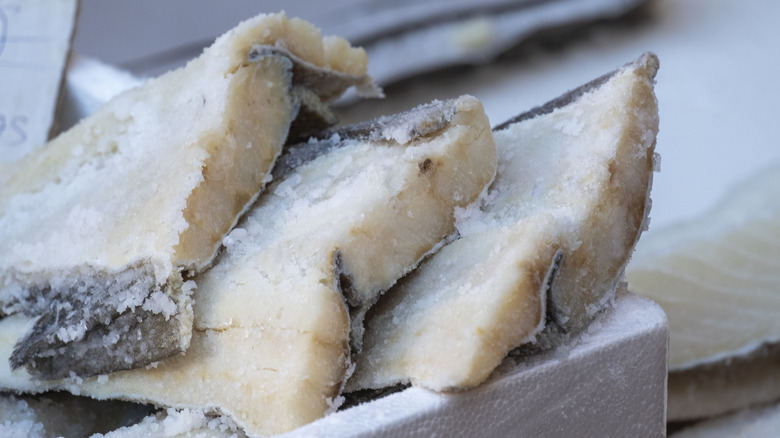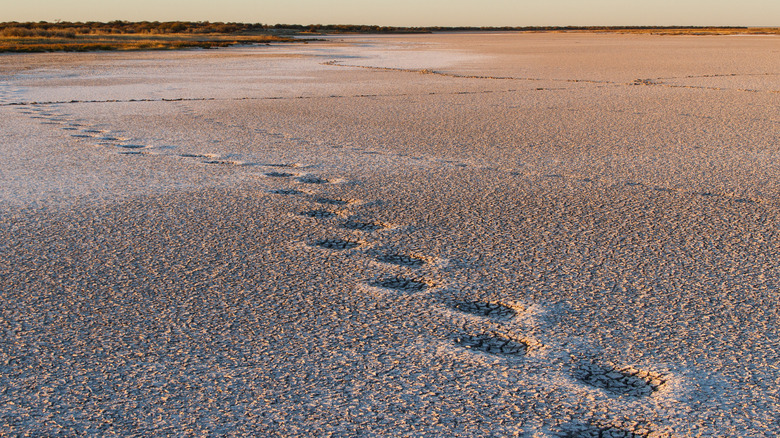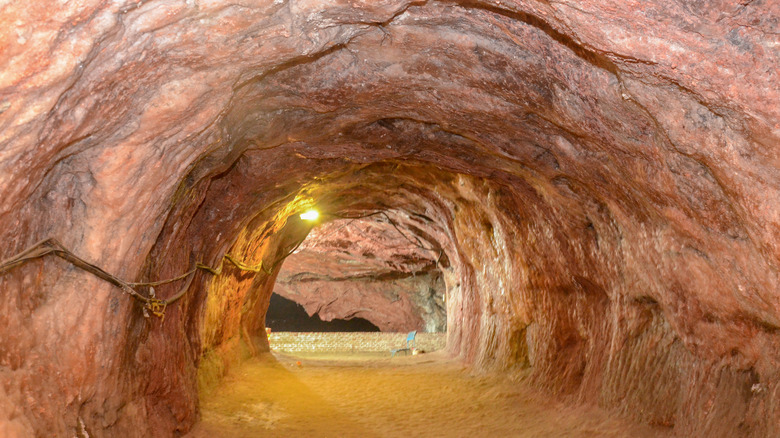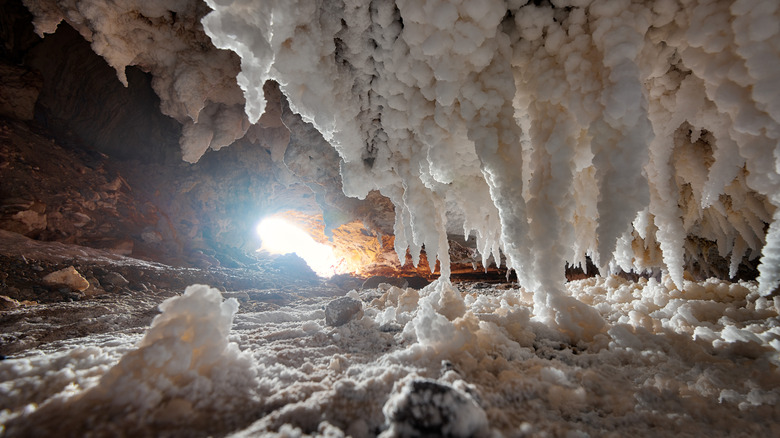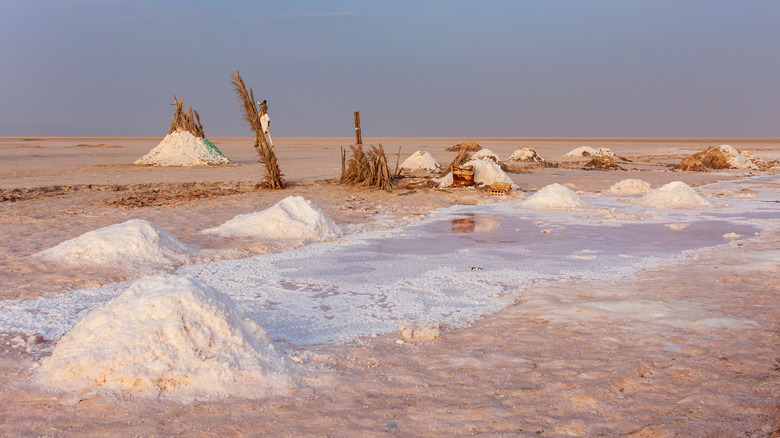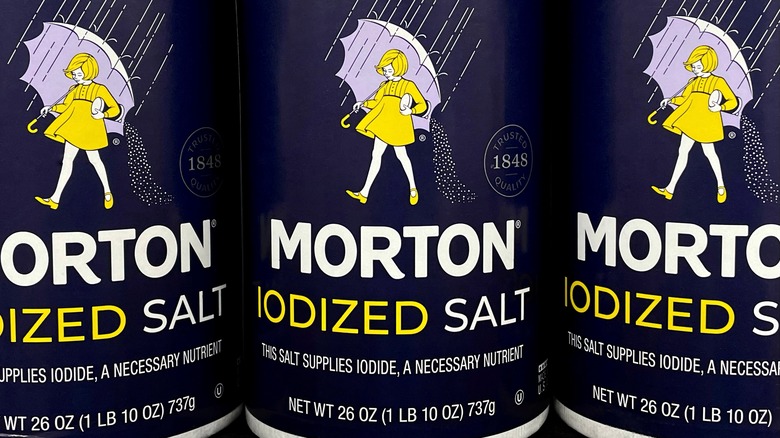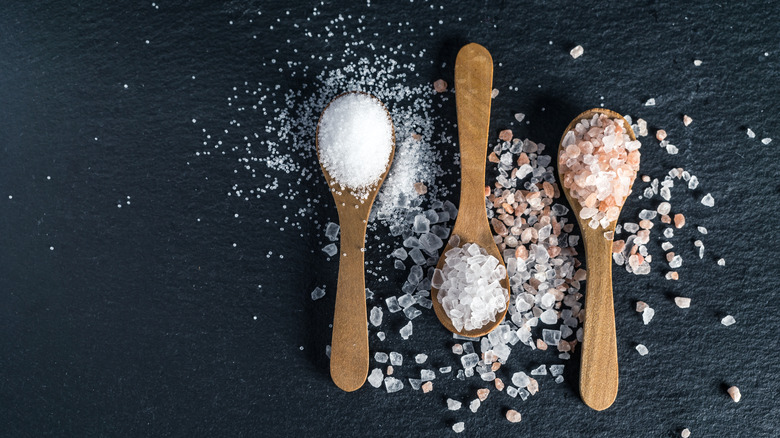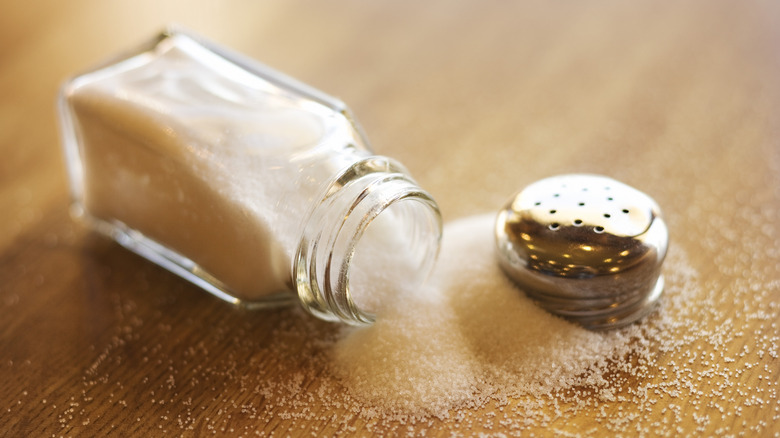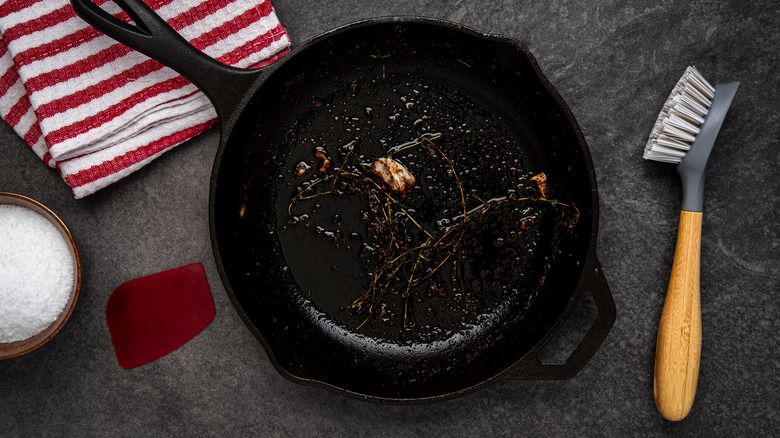Everything You Need To Know About Salt
Top chefs and frozen dinner enthusiasts alike can agree on one thing: salt is the ultimate seasoning that makes the world go round. It's universally loved and heavily used, even to an excess in some regions. And although salt is the most popular seasoning in the world, it is not actually a spice as some might believe. When you think about it, there is actually quite a bit of mystery surrounding a mineral that we consume daily and can't live without.
The untold truth of salt is that it does a lot more than just flavor food. It has shaped human history through cultural rituals, the ability to travel and discover through food preservation, its value as a form of currency, sculpting where humans settled and what lands they fought over, and of course, its nutritional content that allowed humans to continue evolving on this planet. Here's everything you need to know about salt.
You can't live without it
Although the narrative around salt is confusing, it's important to have an understanding of how much salt to eat in order to maintain health. Even though it has a bad reputation, humans need salt to survive. While the average American overconsumes the compound, cutting it out completely could have detrimental effects. The electrolytes in salt are responsible for both water retention and keeping the fluid ratio of the body in check. In addition, it aids in the transmission of nerve impulses. Without salt, we would struggle to function, so it's important to enjoy it in moderation.
But what is salt exactly? Salt is a mineral compound made from sodium and chloride, per Britannica. It's naturally occurring and contains a great concentration of sodium. Sodium, which is commonly mistaken for salt, is simply a piece of the puzzle that makes it up. Sodium is also found in foods like celery, milk, and beets in much lesser concentrations.
Salt was a hot commodity in ancient times
Early on, salt was properly recognized as paramount to human civilization. In ancient Egypt, people collected salt from the Nile river, and as explained by History, were the first to utilize it for its potential as a preservative. They discovered that salt could draw out moisture that caused bacteria formation in foods like meats, and it would preserve them for a great deal of time without the need for refrigeration. They even packed salt around their impeccably preserved mummies.
Per Time, salt was even traded for gold, and slabs of rock salt and salt cakes were used as a form of payment in the sub-Sahara. Ancient Romans also recognized its value and built entire roads to import the commodity. It was recognized for its ability to intensify flavor, preserve foods, and work as an antiseptic, so it's no wonder salt was a driving force in shaping our modern world.
Civilization formed around salt
Prior to humans mining for salt, they reached their required salt intake through the consumption of animal meat, per History. Animals have been indulging in salt before humankind was walking upright, so it's only natural that they are the ones to lead us to the salt licks. They formed their own pathways, and humans followed. Eventually, we constructed roadways leading to these areas and built civilization around them. The value of this natural resource drew in humans from all over, leading to the layout of our modern landscape. Like lakes and other sources of fresh water, areas where salt could be extracted were a safe bet for settlement, and those unable to live within reach would have to engage in the trade systems or travel far and wide.
It seems wherever a salt mine or resource for salt was discovered, humans followed and cities were formed. What wasn't used by the culture was traded for objects as valuable as gold in some areas. This connected many cultures, but also sparked land wars that shaped our modern world.
The salt trade built international relationships
When salt wasn't driving cultures to fight one another, it was bringing people together. The salt trade was alive and vibrant, even in ancient history. Per Salt Works, civilizations like the Phoenicians could use salt as a way to trade with the great powers of the Mediterranean and build relationships between governments. Often, Greek slave traders would take salt in exchange for slaves, making them "worth their salt," which was the origin of the popular saying.
Per World History, regions with naturally occurring salt like the Sahara would regularly trade with areas without, like West Africa. They would run camel caravans back and forth and send salt on boats down the rivers. Expensive metals, hides, and cereals were exchanged for salt in the trade centers. Because rock salt was the most desirable variety, and was prevalent in the Sahara, cultures were desperate to become trade partners. Glassware, fine cloths, and other commodities that came from Isreal, along with spices and texts helped blend cultural practices.
Salt influenced how wars were fought
As it goes, once a valuable natural resource is discovered, the rest of the world has to have it. Many lives have been lost due to battles over precious metals, stones, oil, aquifers, and salt. Before the mineral became an accessible commodity it was constantly the focus of land wars, and salt reserves were targeted to cut off the supply of opposing populations.
The untold truth of Himalayan salt is that it was first commoditized by Alexander the Great, king of Macedonia, who came across the pink rock salt in Pakistan. Since then, the famous colorful salt caves have been owned and conquered by many cultures since.
In the New World, the British tried to deny salt to Americans as a strategy to crumble their new civilization. This didn't work, as salt was discovered across America, and protections were put in place to prevent monopolization of the resource. During the American Civil War, the Confederates ran low on their salt reserves, and it's been suggested that their army suffered from it, per Salt Work Consultants. In fact, the Union army successfully targeted the Confederacy's salt manufacturer in Saltville, Virginia.
Even when people weren't fighting over salt, they were using it as a weapon of warfare.
It comes from the land and sea
It's easy to think of salt as coming primarily from the ocean — after all, if you've ever gotten a mouth full of seawater you'll agree that it's quite salty. The truth is, that salt can come from all over the place, including underground caves, lakes, volcanoes, and even deserts. Salt comes in a variety of colors, forms, and flavors.
Typically, you'll find rock salt and sea salt at your local grocery store. Sea salt is made from evaporated seawater by solar evaporation or by using a vacuum evaporator, while rock salt is mined from underground caves. Special varieties like Himalayan pink salt can only be harvested from a specific location in Pakistan. Rock salt found in caves forms after enclosed lakes, seas, and playas dry up over time, leaving behind mineral beds. These different varieties contain varying minerals and nutrients and even have slightly different flavors.
Salt is an indicator of geological shifts
When a rock salt cave is discovered or salt is found in a desert, it's safe to assume that it didn't just spring up there overnight. Typically, the discovery of concentrated salt in a nonaquatic area indicates a geological shift that took place thousands of years ago.
For instance, the Sahara desert is the center of Africa's salt trade because of its high concentration of salt, found either on the surface with the sand or extracted from shallow salt mines just below the surface, per World History. The explanation for this salty buildup is that the desert used to be underwater.
Even currently, the Dead Sea — one of the saltiest bodies of water in the world — is drying up, according to NPR. The topography of our planet is constantly changing, shifting, and developing whether by natural progression or human intervention. Each salt cave is an indication of a body of water that once was, which is a gold mine for archaeologists and geologists.
Why iodine is added to salt
There are many naturally occurring varieties of salt, but iodized salt is a human-made product that has been around for only a century. There is a historic reason that iodine is added to table salt. Iodine is an important element for human health that is found in soil and the ocean. The mineral regulates the thyroid, which was a major health concern in the 1920s. Goiters, which are irregular growths of the thyroid, were prevalent even in children and it was cause for concern for the government. Starting in Michigan, iodine was added to salt to gain control over the health phenomenon that plagued the region. From there, iodized salt became popular across the United States in order to sneak nutrients into people's diets.
Today, both iodized salt and regular salt are available in stores across the nation. It is likely that your table salt at home and the salt in the table shakers at your favorite restaurant are iodized. Although it goes mostly undetected by the average person, iodized salt has a slightly metallic flavor that top chefs often avoid.
There are many varieties
It may seem like there are really only a few varieties of salt, including kosher, table, and sea salt. But in reality, there are at least a dozen varieties, all with distinct colorings and flavors. Often, the distinguishing features are determined by the region it's extracted from.
Koyuncu Salt describes the most popular varieties. Your typical table salt is usually extracted through either mining or evaporation and has added iodine and an anti-caking agent. Sea salt, as previously discussed, comes from seawater. Lake salt, meanwhile, is highly sought after due to the fact that it typically doesn't contain heavy metals, and comes from salt lakes like the Great Salt Lake in Utah.
Sel Gris, or grey salt, comes from clay-lined pools and is loaded with minerals. Pink salt hails from salt caves in the Himalayas, while fleur de sel, a flakey delicate salt is harvested from the surface of saltwater ponds and shallow seawater in France. Himalayan black salt has a sulfur flavor and is used to give food an eggy taste. Hawaiian black lava salt and Cyprus black salt come, as their names imply, from lava, and Hawaiian red salt comes from red volcanic clay. Celtic grey salt comes from tidal pools off of the Celtic sea.
There are superstitions and religious beliefs about salt
Have you ever seen someone throw salt over their left shoulder, or in movies sprinkle it around the threshold of their home to ward off spirits? Throughout civilization, there has been a great deal of both positive and negative significance placed on the compound.
Per Time, in the Bible, salt symbolized a lack of fertility, while it's later referenced as a symbol of purification after being placed on a baby's lips. For Hawaiians, it carries a similar sense of purity for the mind, body, and spirit, and is used in cultural bathing rituals, as explained by Salt World Wide. As you may have seen in your modern-day life, spilled salt is often considered negative. We can thank the Middle Ages for the ritual of throwing a sprinkling over our left shoulder to evade such doom from spilled salt. While salt was less accessible in the early days, it was used as a status symbol. These are just a smattering of traditions from around the world that use salt as a religious or spiritual symbol. For the bulk of modern Western society, our biggest concern if it's proper etiquette to salt your food before tasting it, and the consensus is if the dining situation is casual, salt away.
The unique relationship between salt and freshness
While we may recognize salt as simply that magic spice that makes everything taste better, it actually has the ability to bring things back from the dead. Well, not actually, but a wrinkled apple will certainly perk up when left in a brine for several hours to soak. Brine is almost a fountain of youth, as it can preserve just about anything, and keep food from oxidizing. In combination with vinegar, nothing goes bad around salt. Think about it — how long has that jar of pickles lasted in your pantry? Salting fish for preservation gave explorers and pioneers the confidence to set sail on long journeys, and may have been an important element in the journey that led Europeans to the New World, per Salt Works.
Like the ancient Egyptians, to this day we use salt as a preservative for cured meats. Bacon, salami, prosciutto, and other meats that seem to last forever have been treated with salt to draw out bacteria-causing moisture. And hey, who doesn't love that salty crunch of bacon in the morning or a salty cut of pepperoni on their pizza? Salt is often used to preserve cheeses as well, which is no surprise as that nippy salty flavor is what drives us to love cheese in the first place.
Use it in your cooking
Even if you're not Gordon Ramsay, it's likely you know your way around a salt shaker when it comes to cooking. Salt is the most used "spice" in the spice cabinet, alongside its trusty sidekick, pepper. The two have seemed to dominate the kitchen scene for centuries and even made their way onto the dining room table.
In addition to enhancing the flavor of food, salt is used by cooks to help water to boil faster (although just by a marginal amount), and helps ice water to drop in temperature. Salt can also be used to draw out bitter properties from vegetables like eggplant by sweating them. In addition, salt can draw out moisture from foods to help them crisp up when cooked.
You should almost always add salt at the start of cooking because it better soaks into hot food more thoroughly, penetrating to the center of the cut or vegetable rather than just glazing the outside. Salt food like a chef and use a three-fingered pinch to ensure you're using enough. In addition, try to sprinkle salt on your dish from a distance, to ensure it spreads evenly throughout.
Low-sodium diets lower blood pressure
While salt is essential for human life, there is no fear that Americans aren't getting enough of the compound. Salt is found in concentrated quantities in processed foods, meats, and cheese, which Americans get an overabundance of. Here's what happens when you eat too much salt: according to the Clevland Clinic, too much can make it difficult for your kidneys to function and pull toxins from the bloodstream. This makes it harder for your heart to pump and increases blood pressure. People with preexisting heart conditions or high blood pressure are often told to decrease their sodium intake.
For those on a recommended low-sodium diet, consider experimenting with other spices in your cabinet. They can add flavor without adding sodium. In addition, lemon juice, lime juice, and vinegar can give your dish that extra punch it deserves without risking your health. Keep table salt off the dining room table, and decrease the number of processed foods you're consuming. Make your own dressings and sauces, stay away from snack foods like chips, and decrease your meat and cheese intake.
Little-known uses for salt
Although we typically think of salt as a go-to seasoning and nothing more, it can actually be used around the kitchen and household in more ways than you might imagine. There are plenty of unexpected uses for salt that you can add to your repertoire of kitchen hacks. For instance, consider experimenting with salt-baking, a technique that uses an egg white and salt base to encase meat when roasting. Make a paste of a salt of your choice and enough egg white to cover the surface, and brush it onto your fish, chicken, or beef. Roast at 400 to 450 degrees Fahrenheit and the dish will steam inside the exterior, which will become crispy as if fried.
Salt can also be used as a cleaner. Try using it to scrub out your cast iron pan when your meal is extra caked on. Because you should never use soap, it can be difficult to get those burnt pieces free from the iron, but coarse salt along with a steel brush should do the trick. Salt can also be used to clean up wine stains on your carpet. Sprinkle it on the spill, and let it absorb the wine to keep it from spreading. Once it has, scrape it up, and go to town with club soda or peroxide.


